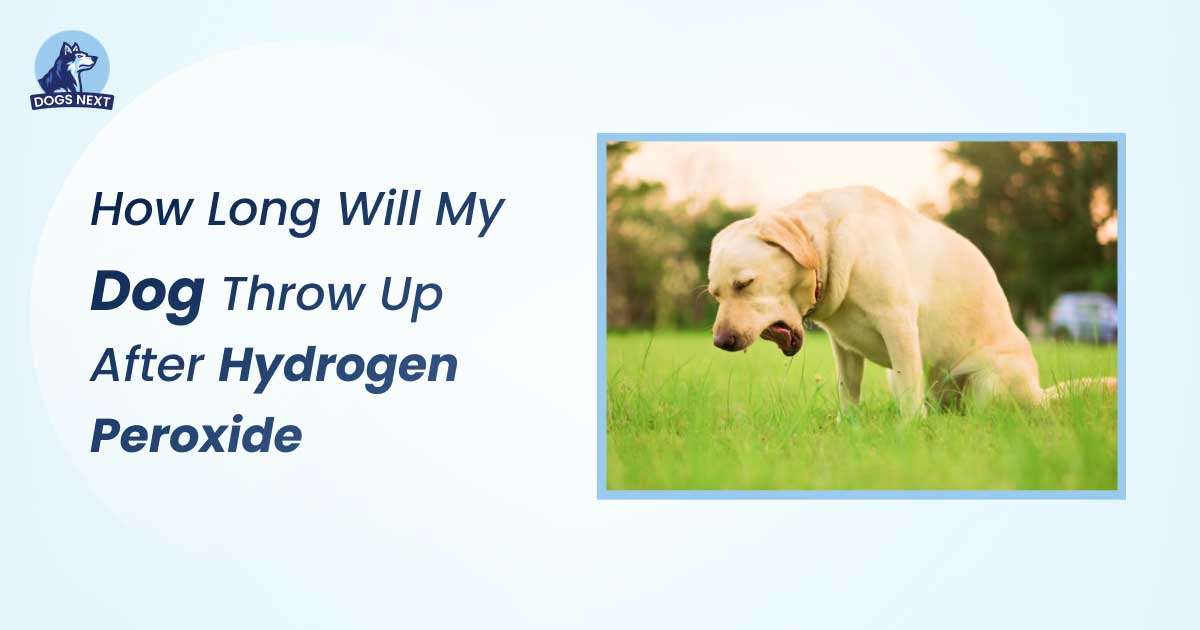Your dog may vomit for about 15-45 minutes after ingesting hydrogen peroxide. Consult your vet if vomiting persists longer.
Hydrogen peroxide is often used to induce vomiting in dogs after they’ve ingested something harmful. It works by irritating the stomach lining, causing them to vomit and expel the substance. Though effective, it should only be used under the guidance of a veterinarian.
Overuse or incorrect dosage can lead to complications such as stomach ulcers or more severe gastrointestinal issues. Always keep a close eye on your dog during this process. Make sure they are hydrated and comfortable. If vomiting continues beyond 45 minutes or if you observe any worrying symptoms, contact your veterinarian immediately for further advice.
Why Hydrogen Peroxide Is Used
Hydrogen peroxide is often used by pet owners to induce vomiting in dogs. This is a common practice when a dog has ingested something potentially harmful. But how long will your dog throw up after taking hydrogen peroxide? Understanding why hydrogen peroxide is used can help you be better prepared for such situations.
Common Situations Requiring Induced Vomiting
There are several scenarios where you might need to induce vomiting in your dog. Here are some common situations:
- Ingestion of toxic substances: Dogs often eat things they shouldn’t, such as chocolate, grapes, or household cleaners.
- Swallowing foreign objects: Items like small toys, socks, or bones can sometimes be swallowed by curious dogs.
- Accidental medication intake: Dogs might get into human or pet medications, leading to an emergency.
Veterinarians typically recommend inducing vomiting within 2 hours of ingestion to maximize the chances of removing the harmful substance. Always consult your vet before inducing vomiting.
How Hydrogen Peroxide Works To Induce Vomiting
Hydrogen peroxide works by irritating the dog’s stomach lining, which leads to vomiting. The standard dosage is 1 teaspoon (5 ml) per 10 pounds of body weight, but it’s crucial to get the dosage right.
- Measure the correct dose: Use a syringe or spoon to measure the hydrogen peroxide.
- Administer the dose: Gently squirt the liquid into the dog’s mouth.
- Wait for vomiting: Your dog should start vomiting within 10-15 minutes.
If your dog does not vomit within this time frame, you should contact your veterinarian immediately. Do not administer a second dose without consulting your vet.
Hydrogen peroxide is a quick and effective method, but it should only be used in emergencies and under guidance. Always keep hydrogen peroxide in your pet first-aid kit for such situations.
Typical Time Frame For Vomiting
Hydrogen peroxide is often used to induce vomiting in dogs who have ingested something harmful. Understanding the typical time frame for vomiting can help dog owners stay calm and prepared. Knowing how long your dog will throw up after hydrogen peroxide is crucial for ensuring your pet’s safety and well-being.
Onset Of Vomiting After Administration
After administering hydrogen peroxide, vomiting typically begins within 10 to 15 minutes. This rapid onset is due to the body’s immediate reaction to the substance. To ensure effective results, follow these steps:
- Administer the correct dosage based on your dog’s size.
- Use a syringe or turkey baster for accurate measurement.
- Ensure your dog is calm and in a safe environment.
Dosage is crucial. Here is a general guideline:
| Dog’s Size | Hydrogen Peroxide Dosage |
| Small Dogs (under 20 lbs) | 1 teaspoon |
| Medium Dogs (20-60 lbs) | 2 teaspoons |
| Large Dogs (over 60 lbs) | 3 teaspoons |
Duration Of Vomiting Episodes
Once vomiting starts, it can last for about 30 to 45 minutes. Most dogs will vomit multiple times within this period. Here are some things to watch for:
- Initial vomiting: This occurs within the first 10 minutes.
- Subsequent episodes: These may follow intermittently.
- Final phase: Vomiting slows down and eventually stops.
During this time, keep your dog hydrated and comforted. Monitor for signs of distress such as excessive drooling, lethargy, or difficulty breathing. If these symptoms appear, contact a veterinarian immediately.
Factors Affecting The Time Frame
Several factors can affect how long your dog will vomit after hydrogen peroxide:
- Dosage: Too much can cause prolonged vomiting; too little may be ineffective.
- Dog’s Size: Smaller dogs react more quickly than larger dogs.
- Age and Health: Older or sick dogs may have a delayed response.
- Type of Ingestion: What your dog swallowed can influence vomiting duration.
- Hydration Levels: Well-hydrated dogs may vomit more efficiently.
Always consult your veterinarian before inducing vomiting. Professional guidance ensures the safety and health of your pet. Understanding these factors helps you better manage the situation and provide the best care for your dog.
Proper Dosage And Administration
Hydrogen peroxide is a common household item used to induce vomiting in dogs during emergencies, like ingestion of toxic substances. Understanding the proper dosage and administration ensures your dog’s safety and effectiveness of the treatment. This section will guide you through the recommended dosage, steps to administer, and important precautions.
Recommended Dosage Guidelines
Administering the correct dosage of hydrogen peroxide is critical. The recommended dosage depends on your dog’s weight. Use a 3% hydrogen peroxide solution.
- Small Dogs (10 pounds or less): 1/2 teaspoon (2.5 ml)
- Medium Dogs (10-50 pounds): 1 teaspoon (5 ml)
- Large Dogs (50+ pounds): 1-2 teaspoons (5-10 ml)
Always measure accurately using a syringe or teaspoon. Avoid using higher concentrations as they can be harmful.
| Dog’s Weight | Hydrogen Peroxide Dosage |
| 10 pounds or less | 1/2 teaspoon (2.5 ml) |
| 10-50 pounds | 1 teaspoon (5 ml) |
| 50+ pounds | 1-2 teaspoons (5-10 ml) |
If unsure about the dosage, consult your veterinarian. Administering too much or too little can affect the outcome.
Steps To Administer Hydrogen Peroxide Safely
Administering hydrogen peroxide safely involves a few critical steps:
- Prepare the Solution: Use a 3% hydrogen peroxide solution. Do not use higher concentrations.
- Measure the Dosage: Use a syringe or teaspoon to measure the correct dosage based on your dog’s weight.
- Position Your Dog: Have your dog sit or stand in a comfortable position.
- Administer the Solution: Gently open your dog’s mouth and squirt the solution into the back of their throat using a syringe.
- Wait for Results: Your dog should start vomiting within 10-15 minutes. If not, you may repeat the dosage once after consulting your vet.
Ensure your dog is calm during the process. Avoid forcing the solution as it may cause choking.
Precautions And Warnings
While hydrogen peroxide can be effective, it’s essential to follow precautions and be aware of the warnings:
- Consult Your Vet: Always consult your veterinarian before administering hydrogen peroxide.
- Use Only 3% Solution: Higher concentrations can cause severe irritation and damage.
- Monitor Your Dog: Watch your dog closely for adverse reactions like excessive vomiting, lethargy, or difficulty breathing.
- Avoid Repeated Use: Do not use hydrogen peroxide repeatedly. It can cause stomach ulcers and other issues.
- Emergency Situations: In severe poisoning cases, seek immediate veterinary care instead of home treatment.
Using hydrogen peroxide improperly can lead to complications. Never use it as a routine vomiting inducer. Always prioritize your dog’s well-being and consult professionals when in doubt.
Monitoring Your Dog
Hydrogen peroxide is often used to induce vomiting in dogs to expel harmful substances. After administering hydrogen peroxide, it’s crucial to monitor your dog closely. Understanding the signs of effective vomiting and knowing when to seek veterinary help ensures your dog’s safety and well-being.
Signs That The Vomiting Is Effective
After giving hydrogen peroxide, you should see your dog vomit within 10-15 minutes. Effective vomiting indicates that the hydrogen peroxide is working. Here are some signs:
- Contents of Vomit: You should see the harmful substance your dog ingested in the vomit.
- Frequency: Your dog may vomit 2-3 times in quick succession.
- Behavior: Your dog may appear relieved or more comfortable after vomiting.
Use this table to keep track of your dog’s vomiting episodes:
| Time | Observation |
| 0-10 mins | Waiting for vomiting to start |
| 10-15 mins | Initial vomiting |
| 15-30 mins | Possible further vomiting |
When To Be Concerned About Persistent Vomiting
If your dog continues to vomit beyond the initial 30 minutes, it may be a cause for concern. Persistent vomiting can lead to dehydration and other complications. Signs to watch for:
- Frequent Vomiting: Vomiting more than 3 times.
- Duration: Vomiting lasting more than 30 minutes.
- Behavioral Changes: Lethargy, weakness, or excessive drooling.
Keep a close eye on these signs and use a journal to record the duration and frequency of vomiting. This information can be helpful if you need to visit the vet.
Symptoms Requiring Veterinary Attention
In some cases, your dog may need immediate veterinary care. Look for these critical symptoms:
- Blood in Vomit: Indicates internal bleeding or severe irritation.
- Severe Lethargy: Your dog is extremely tired and unresponsive.
- Abdominal Pain: Your dog whines or shows discomfort when you touch their belly.
- Difficulty Breathing: Rapid or labored breathing, indicating respiratory distress.
Always err on the side of caution. If you’re unsure about your dog’s condition, contact your vet immediately.
Post-vomiting Care
After inducing vomiting in your dog using hydrogen peroxide, it’s crucial to know how long your dog might throw up and the best post-vomiting care. While the vomiting typically lasts for a short period, the care you provide afterward can significantly impact your dog’s recovery. Here are some essential steps for post-vomiting care to ensure your furry friend returns to normal as swiftly as possible.
Hydration And Rest
Hydration is vital after your dog has vomited. Vomiting can lead to dehydration, so ensure your dog has access to fresh water. Offer small amounts of water frequently instead of a large amount at once to avoid further stomach upset. You can also consider using electrolyte solutions designed for pets to help replenish lost fluids and essential nutrients.
- Offer small amounts of water every 10-15 minutes.
- Use pet-safe electrolyte solutions for better hydration.
Rest is equally important. Your dog needs to relax and avoid any strenuous activities. Create a comfortable resting area where your dog feels safe and secure. Monitor your dog closely during this time to ensure they are not showing signs of distress.
Offering A Bland Diet
After your dog has stopped vomiting and has had time to rest, it’s time to reintroduce food gradually. Start with a bland diet to be gentle on their stomach. A bland diet typically includes boiled chicken or turkey and white rice. Avoid giving any rich or fatty foods that could irritate your dog’s stomach further.
| Food | Preparation |
| Boiled Chicken or Turkey | Cook thoroughly, no seasoning |
| White Rice | Cook until soft |
Start with small portions and gradually increase the amount as your dog tolerates it. Feed small meals multiple times a day instead of one large meal. This helps prevent any additional stomach upset and allows your dog to digest the food properly.
Observing For Any Continued Symptoms
It’s crucial to keep a close eye on your dog for any continued symptoms after vomiting. Look for signs such as lethargy, loss of appetite, diarrhea, or continued vomiting. If any of these symptoms persist, it may indicate a more serious issue that requires veterinary attention.
- Monitor for lethargy or unusual behavior.
- Check if your dog refuses to eat or drink.
- Watch for any signs of diarrhea.
- Note if vomiting continues beyond a couple of hours.
If you notice any worrying symptoms, contact your veterinarian immediately. Early intervention can help prevent more severe health issues and ensure your dog recovers quickly and safely.
When To Contact A Veterinarian
Hydrogen peroxide is often used to induce vomiting in dogs who have ingested something harmful. But how long will your dog throw up after this treatment? More importantly, when should you contact a veterinarian? Knowing the signs and symptoms that require professional help is crucial for your pet’s health.
It’s essential to know when to contact a veterinarian after administering hydrogen peroxide. While mild vomiting is expected, prolonged or severe vomiting can indicate a more serious issue.
Prolonged Vomiting
If your dog vomits for more than 30 minutes, this could be a sign of a serious problem. Continuous vomiting can lead to dehydration and other complications. In such cases, reach out to your veterinarian immediately.
Blood In Vomit
Blood in your dog’s vomit is never a good sign. This could indicate internal bleeding or a severe reaction. If you notice any blood, contact your vet right away.
Lethargy And Weakness
After inducing vomiting, your dog might feel a bit tired. But if you notice extreme lethargy or weakness, this is a cause for concern. Your dog should not be overly tired or weak for an extended period.
Persistent Diarrhea
Vomiting might be accompanied by diarrhea. If diarrhea persists for more than a few hours, it can lead to severe dehydration. Consult your veterinarian to ensure your dog remains hydrated and healthy.
Signs Of Distress
Watch for signs of distress such as excessive drooling, whining, or difficulty breathing. These symptoms could indicate a more severe reaction. If you observe any of these signs, seek veterinary help immediately.
Underlying Health Conditions
If your dog has underlying health conditions like kidney disease or heart problems, it’s crucial to contact your vet as soon as possible. Such conditions can complicate the situation and require professional intervention.
Table: Quick Reference For When To Contact A Veterinarian
| Symptoms | Action |
| Vomiting for more than 30 minutes | Contact Vet |
| Blood in vomit | Contact Vet |
| Extreme lethargy or weakness | Contact Vet |
| Persistent diarrhea | Contact Vet |
| Signs of distress | Contact Vet |
| Underlying health conditions | Contact Vet |
Frequently Asked Questions
Can Hydrogen Peroxide Damage A Dogs Stomach?
Yes, hydrogen peroxide can damage a dog’s stomach. It may cause irritation, vomiting, and gastrointestinal upset. Always consult a vet before use.
How Can I Make My Dog Feel Better After Hydrogen Peroxide?
Give your dog water to drink. Monitor for vomiting or distress. Contact your vet for further guidance immediately. Ensure a calm environment.
When To Feed A Dog After Inducing Vomiting?
Feed your dog 12-24 hours after inducing vomiting. Start with bland food like boiled chicken and rice. Ensure they stay hydrated.
Should I Give My Dog Water After Vomiting?
Yes, give your dog small amounts of water after vomiting. Monitor for further symptoms and consult a vet if needed.
Conclusion
It’s crucial to monitor your dog after giving hydrogen peroxide. Vomiting typically lasts 15-45 minutes. Always consult your vet for proper guidance. Timely action can ensure your pet’s safety. Understanding the process helps you stay prepared. Your dog’s health is paramount, and knowing what to expect can make a difference.

I’m David, an expert contributor and writer, with two furry friends of my own, I know the challenges of raising and caring for dogs. From training to nutrition and health, my goal is to provide valuable insights and advice to help create strong bonds and happy, healthy lives. Find me in Twitter.




